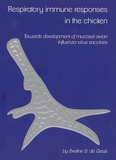Respiratory immune responses in the chicken
Towards development of mucosal avian influenza virus vaccines

Geus, Eveline de
- Promoter:
- Prof.dr. W. (Willem) van Eden
- Co-promoter:
- Dr.ir. L. (Lonneke) Vervelde & dr. J.M.J. Rebel
- Research group:
- Eden
- Date:
- May 22, 2012
- Time:
- 16:15 h
Summary
Several important poultry pathogens, including avian influenza virus (AIV), enter the host through the mucosae of the respiratory tract (RT) and subsequently disseminate towards other organs in the body. Therefore, animal health significantly depends on the control of infection in the lung tissue by the RT immune system. There is limited knowledge of the lung-associated immune system in poultry, which might be a consequence of the unique and complex anatomy and function of the avian lung. The rational design of mucosal vaccines requires a comprehensive knowledge of the structure and function of the RT immune system in order to target vaccines appropriately and to design efficient mucosal adjuvants. We therefore studied uptake of antigen (Ag) in the RT and the humoral immune responses after AIV infection. Furthermore, we tested the feasibility of respiratory applied adjuvanted whole-inactivated influenza vaccine (WIV) for use in a rapid intervention strategy. We used LPS-coated and AIV-coated beads to mimick uptake of bacterial and viral Ag and identified different subsets of macrophages and dendritic cells (DC) in chicken lung, based on expression of CD11, activation markers and DEC205. In vivo uptake of LPS-beads and AIV-beads resulted in up regulation of co-stimulatory molecules of different subsets of phagocytic cells, with the MHC II+ and CD80+ bead+ cell population containing the DC based on the absence of phagosomal acidification. LPS-bead+ cells were present in bronchus-associated lymphoid tissue, suggesting local induction of immune responses [J Immunol 2012]. We then studied humoral immune responses following primary and secondary influenza infection. As expected, IgM responses predominated during primary infection. Antiviral IgA and IgY responses were induced both locally in the lung and systemically in the spleen. Responses in the lung preceded responses in the spleen, indicating that respiratory immune responses were locally in the lung [Dev Comp Imm 2010]. When chickens were aerosolized or intranasally vaccinated with adjuvanted WIV no AIV-specific Ab-responses were detected. However, the vaccine did enter the RT as cholera toxin B subunit (CT-B)-specific antibodies were detected in chickens vaccinated with the CT-B-adjuvanted vaccine and therefore the adjuvanted aerosol vaccination technique is in principle feasible to use [Vet Imm Immpathol]. As in our hands a respiratory applied WIV vaccine did not induce an AIV-specific antibody response, future research for mucosal vaccination strategies should focus on alternatives such as enhancing retention time through the use mucoadhesives, application of immunomodulatory compounds suitable for the mucosae, and increase the Ag uptake by the selective targeting of RT-DC subsets. Finally, we characterized the antibody responses against virus glycan epitopes using glycan-arrays and identified immunogenic virus antigens. To increase our understanding of the interaction between avian influenza virus and its chicken host, we identified receptors for putative avian influenza virus glycan determinants on chicken dendritic cells based on glycan-binding properties and C-type lectin receptor (CLR) mRNA expression. In conclusion, a step towards the understanding of the immune system in the respiratory tract of the chicken has been made and will contribute to the rational design of novel vaccines for mucosal vaccination against AIV.